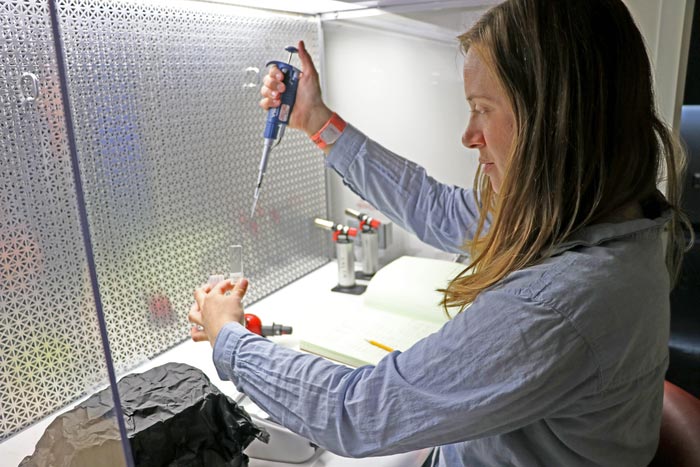‘Photosynthetic’ algae can survive the dark

Jelena Godrijan performs measurements on coccolithophores during long-term experiments at Bigelow Laboratory for Ocean Sciences. The work led to a discovery of how some species of single-celled algae survived the last mass extinction, a finding that could change how we understand global ocean processes.
Credit: Bigelow Laboratory for Ocean Sciences
More than 66 million years ago, an asteroid impact led to the extinction of almost three-quarters of life on Earth. The little life that was left had to struggle, and research into its tenacity can provide key insights into how organisms survive environmental challenges. In a new study, scientists at Bigelow Laboratory for Ocean Sciences discovered how some species of single-celled algae lived through the mass extinction, a finding that could change how we understand global ocean processes.
Coccolithophores, like most algae, are photosynthetic and utilize the sun’s energy to make food. However, the aftermath of the asteroid impact was thought to have blanketed the planet with several months of darkness, a death sentence for most of the world’s photosynthetic organisms. In combination with other fallout effects, this caused the extinction of more than 90 percent of all coccolithophore species, some of the most influential organisms in the ocean. However, others endured.
As part of the new study, the team conducted laboratory experiments that showed some coccolithophores could survive without light. This revealed that the organisms must have another way to produce the energy and carbon that they need.
“We’ve been stuck on a paradigm that algae are just photosynthetic organisms, and for a long time their capability to otherwise feed was disregarded,” said Jelena Godrijan, the paper’s first author, who conducted the research as a postdoctoral scientist at Bigelow Laboratory. “Getting the coccolithophores to grow and survive in the dark is amazing to me, especially if you think about how they managed to survive when animals like the dinosaurs didn’t.”
The study revealed how some coccolithophore species could use previously unrecognized organic compounds as carbon sources instead of carbon dioxide, which is what plants usually use. They can process dissolved organic compounds and immediately utilize them in a process called osmotrophy. The findings may explain how these organisms survive in dark conditions, such as after the asteroid impact, or deep in the ocean beneath where sunlight can reach.
The research was published in the journal New Phytologist and co-authored by two other researchers at Bigelow Laboratory, Senior Research Scientist William Balch and Senior Research Associate David Drapeau. It has far-reaching implications for life in the ocean.
Coccolithophores are integral to processes that control the global ocean and atmosphere, including the carbon cycle. They take in dissolved carbon dioxide from the atmosphere, which gets transported to the ocean floor when they die.
“That’s hugely important to the distribution of carbon dioxide on Earth,” said Balch. “If we didn’t have this biological carbon pump, the carbon dioxide in our atmosphere would be way higher than it is now, probably over two times as much.”
Coccolithophores also play an important role in mitigating ocean acidity, which can negatively affect organisms like shellfish and corals. The single-celled algae remove carbon from the water to build protective mineral plates made of limestone around themselves, which sink when they die. The process effectively pumps alkalinity deeper into the ocean, which chemically bolsters the water’s ability to resist becoming more acidic.
The new study revealed that the algae also take in carbon from previously unrecognized sources deeper in the water column. This could connect coccolithophores to a new set of global processes and raises fundamental questions about their role in the ocean.
“Coccolithophores are integrated into global cycles in ways that we never imagined,” Balch said. “This research really changes my thinking about food webs in dark regions where photosynthesis clearly isn’t happening. It changes the paradigm.”
The researchers next want to perform ocean experiments to observe how coccolithophores take in nutrients in their natural environment, especially in the dark. Godrijan hopes her work will help reveal more about the organisms, their significance, and their complex role on our planet.
“Coccolithophores are tiny, tiny creatures, but they have such huge impacts on all life that most people are not even aware of,” Godrijan said. “It brings me hope for our own lives to see how such small things can have such an influence on the planet.”
Bigelow Laboratory for Ocean Sciences is an independent, nonprofit research institute located in East Boothbay, Maine. From the Arctic to the Antarctic, Bigelow Laboratory scientists use innovative approaches to study the foundation of global ocean health and unlock its potential to improve the future for all life on the planet. Learn more at bigelow.org, and join the conversation on Facebook, Instagram, and Twitter.
Journal: New Phytologist
DOI: 10.1111/nph.17819
Article Title: Osmotrophy of dissolved organic carbon by coccolithophores in darkness
Article Publication Date: 16-Nov-2021
Media Contact
Fritz Freudenberger
Bigelow Laboratory for Ocean Sciences
fritz@bigelow.org
Office: 207-315-2567 x111
Original Source
All latest news from the category: Studies and Analyses
innovations-report maintains a wealth of in-depth studies and analyses from a variety of subject areas including business and finance, medicine and pharmacology, ecology and the environment, energy, communications and media, transportation, work, family and leisure.
Newest articles

High-energy-density aqueous battery based on halogen multi-electron transfer
Traditional non-aqueous lithium-ion batteries have a high energy density, but their safety is compromised due to the flammable organic electrolytes they utilize. Aqueous batteries use water as the solvent for…

First-ever combined heart pump and pig kidney transplant
…gives new hope to patient with terminal illness. Surgeons at NYU Langone Health performed the first-ever combined mechanical heart pump and gene-edited pig kidney transplant surgery in a 54-year-old woman…

Biophysics: Testing how well biomarkers work
LMU researchers have developed a method to determine how reliably target proteins can be labeled using super-resolution fluorescence microscopy. Modern microscopy techniques make it possible to examine the inner workings…





















